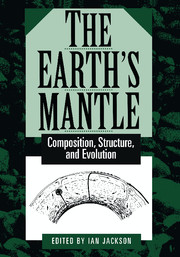Book contents
- Frontmatter
- Contents
- Chapter Outlines
- Contributors
- Dedication
- Preface
- I Accretion and Differentiation of the Earth
- II Dynamics and Evolution of the Earth's Mantle
- III Structure and Mechanical Behaviour of the Modern Mantle
- 8 Seismic Structure of the Mantle: From Subduction Zone to Craton
- 9 Composition and Temperature of the Earth's Mantle: Seismological Models Interpreted through Experimental Studies of Earth Materials
- 10 The Viscosity of the Mantle: Evidence from Analyses of Glacial-Rebound Phenomena
- 11 Mantle Rheology: Insights from Laboratory Studies of Deformation and Phase Transition
- Index
10 - The Viscosity of the Mantle: Evidence from Analyses of Glacial-Rebound Phenomena
Published online by Cambridge University Press: 23 November 2009
- Frontmatter
- Contents
- Chapter Outlines
- Contributors
- Dedication
- Preface
- I Accretion and Differentiation of the Earth
- II Dynamics and Evolution of the Earth's Mantle
- III Structure and Mechanical Behaviour of the Modern Mantle
- 8 Seismic Structure of the Mantle: From Subduction Zone to Craton
- 9 Composition and Temperature of the Earth's Mantle: Seismological Models Interpreted through Experimental Studies of Earth Materials
- 10 The Viscosity of the Mantle: Evidence from Analyses of Glacial-Rebound Phenomena
- 11 Mantle Rheology: Insights from Laboratory Studies of Deformation and Phase Transition
- Index
Summary
Introduction
Our knowledge of the bulk composition of the Earth is well constrained by observations that include cosmic elemental abundances and laboratory analyses of rock and mineral samples originating from the mantle (e.g., Ringwood, 1975; O'Neill and Palme, Chapter 1, this volume). Also well constrained are the bulk elastic properties of the Earth through the analysis of seismic wave propagation (e.g., Kennett and van der Hilst, Chapter 8, this volume) and analyses of tides and the planet's rotation. But less satisfactory is our understanding of the time-dependent or viscous response. Various geophysical observations indicate that stress and strain in the planet as a whole are not in phase, as seen in observations of the Earth's tides, and that the mantle creeps when subjected to stress, as demonstrated by crustal rebound after removal of ice loads. But we do not have a complete description of the solid Earth's departures from elasticity. Laboratory experimentation on terrestrial materials indicates that the nonelastic response of the mantle is dependent on the defect nature of the solid, such as dislocation density and dislocation mobility, which in turn are functions of the ambient temperature, pressure, and nonhydrostatic stress. Thus, at seismic frequencies, the response to an applied oscillatory stress is out of phase because of the finite diffusion time of the atoms around the dislocation, whereas for longer-term motions associated with tectonic stresses the response is described in terms of a solid-state viscosity.
- Type
- Chapter
- Information
- The Earth's MantleComposition, Structure, and Evolution, pp. 461 - 502Publisher: Cambridge University PressPrint publication year: 1998
- 14
- Cited by



